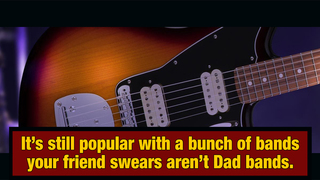Fender's Jazzmaster Guitar Was Hated By Jazz Musicians (But Changed Music History)

Even if you don't play guitar, you know Fender guitars. The Stratocaster and Telecaster's signature models were favorites of guitarists across all kinds of genres as early as the 1950s. You might know them as "the one Hendrix played" ...
... or "the one Springsteen played" or even "the one that my ex-boyfriend had, but 'played' is too kind a word to describe what he does," depending on your musical tastes and life experiences. Those guitars are everywhere.
Everywhere except in the hands of jazz players, that is. Fender's top models have never quite fit with what jazz guitarists needed. Jazz players have traditionally preferred what's called a semi-hollow guitar. See, back in the day, guitar amps weren't all that good, so jazz players used semi-hollow or hollow-bodied instruments because they were loud enough to back up big bands with trumpets and saxophones and trombones. This essentially codified the typical jazz sound as having a richer, more buttery tone than the abrasive distortion of rock and pop.
Don't Miss
Additionally, jazz guitarists were rarely bandleaders or the focus of the music. Most of the time, as a jazz player, you're supposed to quietly chunk chords while horn players wail away. Eventually, when it's your turn to solo, everyone else stops, and you get a precious minute or so to shine. It's a very different musical composition from, say, a metal band.

Fender founder and engineer Leo Fender (famously not a guitarist) set out to change that with the Jazzmaster. Fender couldn't break into the jazz market, and breaking into markets is a brand's favorite thing to do. So Leo set out to design a fancier guitar perfect for jazz. If you look at a Jazzmaster, you'll see a bunch of knobs and switches most guitars don't typically have. It's designed to give players a ton of leeway to switch between which pickups they use (those little rectangle things on the body) and how the electronic signal is sent to the amp. Two channels were even deliberately designed as "rhythm" (for when the horn players are wailing) and "lead" (for when the guitarist gets to solo). He even designed the guitar's body to be offset and thus more comfortable for playing sitting down, which most jazz guitarists did.
The only problem? Jazz guitarists still wouldn't play it. Like your parents refusing to cancel their landline, they simply didn't see a need to switch from what they knew. What makes this story even weirder is that Leo was famous for obsessively working with guitarists, throwing instruments into player's hands moments before they went on stage, and asking for feedback after gigs. He estimated he spent 25% of his working day talking to guitarists. For whatever reason, though, he didn't do that with the Jazzmaster. (Did they smell like swamp ass from sitting while sweatily playing?)

The guitar did find an audience, however, with 60s surf guitarists. These were sparklingly-toothed boy bands from southern California singing songs for teenagers and playing with sounds that mimicked surf waves. Not exactly the highbrow, upper-crust luminaries Leo was going for. Instead of backing Miles Davis or John Coltrane, Leo's new design was soundtracking campy cop shows or songs about little deuce coups. Sales were steady enough, though, for as long as surf music was popular.
By 1980, though, sales had declined. The model was discontinued and became a pawn shop novelty. It didn't take long, though, to gain popularity with the kinds of hipsters who like pawn shop novelties. Elvis Costello and My Bloody Valentine were among the first Jazzmaster fans. Kurt Cobain never played a Jazzmaster, but he loved to mess around with similarly weird-bodied Fenders, even designing his own, which definitely helped bring unconventional axes into the mainstream.

Fender reissued the Jazzmaster in 1996, it's still popular with a bunch of bands your friend swears, "Aren't dad bands! Screw you; we're not getting older! I will never die." -- The War on Drugs, The Minutemen, Dinosaur Jr., and Radiohead, to name a few. It has something a countercultural, non-traditional appeal, and has undeniably been used to make some interesting and diverse sounds (I mean, just try to draw a throughline from The Beach Boys to My Bloody Valentine). Leo might have failed miserably with his target audience, but he still succeeded in attracting a bunch of genius weirdos to his genius weirdo design.
Top image: Fender